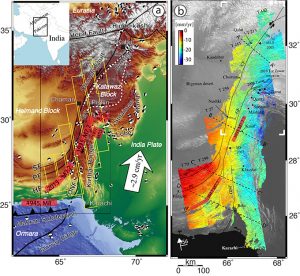
University of Miami (UM) Rosenstiel School of Marine and Atmospheric Science scientists have revealed alarming conclusions about the earthquake hazard in the Afghanistan-Pakistan border region. The new study focused on two of the major faults in the region— the Chaman and Ghazaband faults.
“Typically earthquake hazard research is a result of extensive ground-based measurements,” said the study’s lead author Heresh Fattahi, a UM Rosenstiel School alumni. “These faults, however, are in a region where the political situation makes these ground-based measurements dangerous and virtually impossible.”
Using satellite data from 2004-2011acquired by the European Space Agency satellite Envisat, and interferometry, the researchers were able to measure the relative motion of the ground and then model the movement of the underlying faults with an accuracy of just a few millimeters. Using data for a seven-year timeframe using time-series analysis techniques increases the confidence in their results.
The new study shows that the Ghazaband fault is accommodating more than half of the relative motion between the Indian and Eurasian tectonic plates, which indicates that the fault accumulates stress and the potential for a high magnitude earthquake is much higher than previously thought.
Quetta, the capital of Pakistan’s Balochistan province and located close to the Ghazaband Fault, lost nearly half of its population following a magnitude 7.7 earthquake in 1935.
“Quetta’s population of more than one million is in serious danger if an earthquake were to strike,” said Falk Amelung, a UM Rosenstiel School professor of geophysics and a coauthor of the study. “Earthquake-proof construction is vital in avoiding earthquake disasters. Quetta, as well as other cities in the region, is completely unprepared.”
The research team also studied the Chaman Fault, the largest fault in the region, running from southern Pakistan to north of Kabul, Afghanistan’s capital. This fault was thought to accommodate the lion’s share of the relative plate motion, but the satellite data reveal that it may account for only about one third of it.
“We have to rethink the tectonics of the region,” said Amelung.
The researchers also found a creeping segment, where the rock masses slide against each other without accumulating any stress that would lead to earthquakes. The creeping fault extends for 340 kilometers (211 miles).
“This is the longest creeping fault ever reported,” said Fattahi.
The slower than expected fault rate and the presence of the long creeping segment explains why the region has not, for over 500 years, experienced major earthquakes with fault ruptures from several tens to several hundreds of kilometers. However, they warn, this does not mean there is no hazard.
Note: The above post is reprinted from materials provided by University of Miami.










